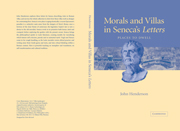Book contents
- Frontmatter
- Contents
- Acknowledgements
- Introduction
- 1 Twelve steps to haven
- 2 Dropping in (it) at SENECA'S
- 3 You can get used to anything
- 4 The long and winding mode
- 5 Booking us in
- 6 Now and then; here and there: at SCIPIO'S
- 7 Bound for VATIA'S
- 8 Knocking the self: genuflexion, villafication, VATIA'S
- 9 The world of the bath-house: SCIPIO'S
- 10 The appliance of science: SCIPIO'S
- 11 Shafts of light: transplantation and transfiguration
- 12 Still olive, still SCIPIO'S
- Appendix 1 Here to stay Places and persons named in the Epistulae Morales
- Appendix 2 From: Letter 86 To: A Dying Light in Corduba
- Bibliography
- Indexes
10 - The appliance of science: SCIPIO'S
Aegialus in Letter 86; with: Virgil's funny farm
Published online by Cambridge University Press: 22 September 2009
- Frontmatter
- Contents
- Acknowledgements
- Introduction
- 1 Twelve steps to haven
- 2 Dropping in (it) at SENECA'S
- 3 You can get used to anything
- 4 The long and winding mode
- 5 Booking us in
- 6 Now and then; here and there: at SCIPIO'S
- 7 Bound for VATIA'S
- 8 Knocking the self: genuflexion, villafication, VATIA'S
- 9 The world of the bath-house: SCIPIO'S
- 10 The appliance of science: SCIPIO'S
- 11 Shafts of light: transplantation and transfiguration
- 12 Still olive, still SCIPIO'S
- Appendix 1 Here to stay Places and persons named in the Epistulae Morales
- Appendix 2 From: Letter 86 To: A Dying Light in Corduba
- Bibliography
- Indexes
Summary
At the hinge between the two grand topics combined in Letter 86, we were given notice that disjunction in tone should feature in our reception of what lies ahead. By implication we may be promised a lightening of tone, as we move from Schloss scipio, on to a lesson we can learn from the present owner (haec si tibi nimium tristia uidebuntur, 14). But this is not spelled out, and the letter of the text even locates the up and coming lesson firmly ‘inside’ the very selfsame ‘mansion’ wherein we have just learned our lesson in lugubrious revulsion (in uilla).
If, or rather, since, as we just saw (in chapter 9: pp. 107, 115–17), it is a major test of the reader's own orientation to suggest that they may not have wallowed in Scipio's cranny and may not have exulted in Seneca's diatribe (haec si tibi nimium tristia uidebuntur, 14), there is a firm underlying directive to anticipate something just as excessively ‘grim’ in store. This editorial hinge (diuisio) even amounts to a boast that what follows will live up to the mighty scipio. We are cued to read as ‘conscientiously’ as we can (diligentissimo). Here, now, today, under present management, the site is Roman respectability itself (patre familiae).
THE FIELD TRIP
‘Within’ the estate, Seneca learns to think of the locus as ‘farmland’ (huius agri).
- Type
- Chapter
- Information
- Morals and Villas in Seneca's LettersPlaces to Dwell, pp. 119 - 138Publisher: Cambridge University PressPrint publication year: 2004



